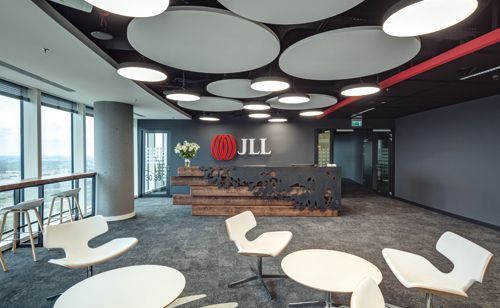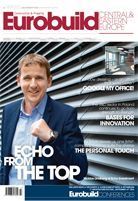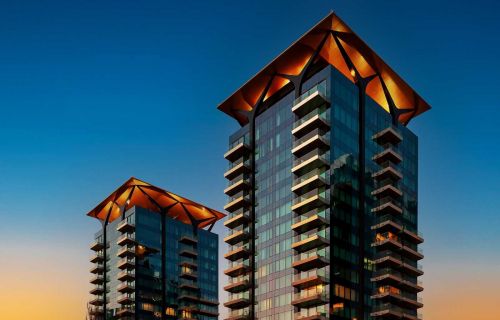Google my office!
Office & mixed-use development
Consultancies that have recently opened or extended departments have embraced the concept of the cutting edge workplace. Special units have been set up and given responsibility for this, while furniture suppliers are also responding to the demands of modern offices. Is this simply creating a new source of demand? After a conversation with the most important players of the workplace segment in Poland and those on more developed markets, it turns out that this approach is simply the most profitable one. And it confirms the old Polish saying: if you don’t know what’s going on, it’s about the money.
The names vary: workplace strategy, workplace solutions, office space optimisation, flexible office concepts, activity-based working and workplace innovation. And the point simply is to create an office that will keep employees satisfied and healthy. This begs the question of why a company needs a satisfied employee – after all, shouldn’t they just be happy that they have a job? However, a truly satisfied employee is more efficient, loyal and also healthier thanks to the ecological systems installed in the office, so they more rarely go on sick leave and are able to accomplish more. And more precisely, too. This translates into a more profitable company: money is saved from not wasting time or resources and from avoiding mistakes, while money can be generated from projects completed more efficiently and from outdoing the competition. “It is not enough for an employee to have a desk, a chair and the internet. They should also have the maximum comfort and their health looked after. Such an employee is more productive and they are more attached to their company,” believes Regina Gul, the senior project manager in the project management department at JLL, which works on the analysis and planning of the work environment (workplace consultancy). “What worked well in a company just 15 or 20 years ago is completely inadequate to work needs now. And this concerns not just the space in which we function, but also the organisational culture, management style and everything related to the workplace in general. A working environment created by how the space is organised as well as certain rules and by the functioning of this space,” claims Dorota Osiecka, the director of the newly-established workplace innovation department at Colliers International.
Employee as a designer
The optimisation process, as it is called by JLL, starts before the stage of designing a new office but it can also be carried out in an existing one. The analysis is carried out not just by architects, as was the case with the old model. Now those involved include sociologists, anthropologists, psychologists, analysts as well as employees, directors and the company’s management. Architects and interior designers come in at the very end of the process. Because the architecture is not the issue. “For architecture and, in particular, for real estate to be the catalyst for a better experience, it needs to be holistic in its purpose. To quote Le Corbusier: a house is a machine for living,” explains Derrick Bock, a partner and head of workplace strategy at Cushman & Wakefield. So what do we do if we want to have a properly functioning machine for working? “It is important not to lose sight of implementing this in a meaningful and intuitive way, focusing on the end-user as the asset. Focusing on what is going to make – from a design and architectural perspective – a meaningful connection with the individual. Understanding these human-contact points and integrating them into the solution will inevitably make the space more successful,” Derrick Bock adds. “Old space is not amenable to change. Traditionally arranged office space is not flexible, it is not able to be adapted to changes in an organisation. And this is a big disadvantage because organisations change very quickly in the modern world,” says Dorota Osiecka.
Testing on your own skin
The consultancies that offer workplace solutions have decided to experiment on themselves to see how this actually works. JLL has moved to the Warsaw Spire office complex, where it has implemented the workplace strategy process from start to finish. BREEAM certification is also being carried out for the interiors. Meanwhile, Colliers International has established a new team – EMEA Workplace Solutions. This company has tested out innovations from the world of office furnishing on a ‘live organism’, i.e. its Polish head office in the Metropolitan office building on pl. Piłsudskiego. The appropriate location of departments is very important in the new concept, in order to streamline the communication and information transfer. “If departments cooperate with each other on an everyday basis, it is worth putting them next to each another. For example, we, as the construction project management department, cooperate closely with the office leasing department. We meet clients together and we have a lot of internal meetings that involve both departments during which we discuss, for example, details of leases. If departments that cooperate with each other are located in various parts of the office, their communication deteriorates; there is no information flow, which might negatively impact the company. Basically, laziness wins out – I don’t feel like going one floor up to my colleague just to ask him about a ‘trivial’ thing. Meanwhile, departments that disturb each other should not be next door neighbours. After all, there are teams whose everyday work requires focus, such as finance and accountancy. A bad layout could also result in diminished decision making skills, which is not a positive phenomenon for the entire company and could have a negative impact on its results,” explains Regina Gul. According to research on workplace environment and strategy, employees lose an average of 40 minutes per day trying to find each other or find a room for a meeting in a badly organised office – and this is time that can be regained if changes are made. And such a waste of time is a real waste for the company. Advocates of the new trend say that it is not always possible to save space on the basis of shared desks. Work specification varies, in entire companies as well as in individual departments – such as with accountants and IT specialists, who spend all day at their desks.
According to studies, the most effective teams and organisations are those in which there is the most cooperation and the highest level of information exchange, within teams as well as among those that neighbour each other and with the rest of the organisation. “Innovation and creativity – this is the key factor in the market nowadays. It is not enough just to be good – you always need to be one step ahead. Space that makes this possible or simply induces employees from departments to meet and exchange ideas or talk on topics not really related to work issues, has an impact on the information flow, the ties and the level of cooperation in an organisation. And all this means an improvement in strictly business factors, such as the level of productivity, the speed of decision making and the time-to-market. The period from coming up with an idea to launching it should be as short as possible. A well-configured work environment could help us in this respect,” claims Dorota Osiecka.
Does the expense ever pay for itself?
All the market representatives we spoke to admit that such services are indeed more expensive than a straightforward design from an architect. However, all of them added that it is profitable and pays for itself very quickly. “If an area is effectively used, there are no empty square metres left unused but costing money. This is quite a narrow view, but we also have such a perspective when discussing a project. However, it should not be the only issue, because it could result in creating areas that are not necessarily people-friendly. The second factor that should be taken into consideration is the issue of efficiency, the productivity of our business processes, i.e. can we affect the speed of decision making and streamline business processes by changing something in the way we operate? This in turn translates into actual profits, even though these can’t be seen at first sight. However, it is possible to see them clearly in the annual balance sheet,” admits Dorota Osiecka.
A showpiece nonetheless
“There is also the issue of the satisfaction and motivation of employees as well as the company’s own brand. The area is a means of communication. The appearance of our environment tells us something about who we are as an organisation; we communicate this to our clients who come here. Each guest takes in the whole area with all their senses. Even if they do not come any further into our office, they know something about us,” points out Dorota Osiecka of Colliers. Apart from this external communication there is also the internal communication. “Through the shape of the office space we can show our employees who they are for us, what we expect from them, how they function here and what the culture of the organisation is. It is important that the space is a tool for the encouragement and fostering of behaviour that is positive for us and for eliminating those that generate negative effects for us,” concludes Dorota Osiecka. JLL has a similar approach. “Our thinking is long term and it is profitable for us. Our office and our approach are our showpiece and an example for our clients,” declares Regina Gul. “I think the responsibility lies with us to educate clients about basic needs. It is essential to ask: are you using your new office as a magnet, to attract staff to come work for you, or are you just interested in design and you want to make your mark through the wow factor? Is this going to make your people more productive? It’s critical to do this in a way which avoids throwing money out of the window, so we try to give our clients the bigger picture, while focusing on what they need to be successful,” says the director at Cushman & Wakefield. Offices designed in line with the latest standards are also healthier. “We have more oxygen and we feel better thanks to this. It is easier to work and so we work more efficiently. The paints and varnishes do not contain volatile organic compounds and the wooden components do not have the formaldehydes that are harmful to health. This is also included in the BREEAM certification for our office,” reveals Regina Gul of JLL.
Savings at the leasing stage
Based on the calculations of the consultancies, a client knows the optimal space they should look for. “Without an analysis it sometimes seems that an entire floor would be suitable, whereas this might be far too much. If everything is well calculated, this turns into real amounts saved per month or year,” explains Regina Gul. However, if we want to change our premises without moving, there are two ways: you can save on the area – lease less and pay less – or create a collaboration area on under-used space, or a large kitchen, a meeting place, a business meeting place, additional telephone booths or conference rooms. “For example, we once drew up a report for a pharmaceutical company, which had a gym in its office and nobody used it; after our report and some discussions they decided to use the area for leisure space, as this was missing in the office,” recalls Regina Gul.
Grassroots initiative
“Interestingly, a growing awareness among companies on the market is now becoming evident. They are asking us about such workplace solutions. They mostly say that they want to change something because their employees are complaining. Companies do not just want to do things cheaply but they want to keep their people and they want their employees to be satisfied. The rivalry over talent is now hotting up. Young people, who are valued, have their requirements. The youngest generations now entering the job market want to work in a cool office. For companies, it is about attracting the best and the most valuable candidates. People are also mobile now, they can see how people work in other countries, so they have comparison points and know what they should expect,” adds Regina Gul. This new attitude from companies is confirmed by Colliers International. “It was a natural follow-up of the services that Colliers offers. The idea for setting up the new department came both directly from our clients and from the management board,” reveals Dorota Osiecka.
Architects move out of the spotlight
Many companies believe that it is better to employ an architect to design their offices. “Architects have their own ideas, which they often replicate. But the true picture of a company’s needs only emerges through interviews with people. An architect does not normally do this. It is not all about making things pretty or arranging conference rooms that nobody will use,” argues Regina Gul. “A new office is not for the company’s president to like, but should be liked by the people who work there – they have to be satisfied. This is important for an employee because they can see that the company listens to them and it shows that they care for and respect the employee. The fact that a company has a nice office is not just a marketing benefit,” sums up the JLL manager. According to market specialists, a modern office could have any form, it could even be ‘old fashioned’, it can include studies. Hot-desks are not necessary and departments do not have to sit together. The trick is to adapt it to the specific character of that particular company. “It is not the case that we come in and say ‘wow!’ On the contrary, well designed and functional offices sometimes look rather modest and ordinary,” says Dorota Osiecka. “According to the current style of working, the majority of companies focus on the independence and creativity of their employees, with a simultaneous emphasis on the exchange of information and knowledge. The office then becomes a place for meetings with the team and exchanging knowledge and experience.
It has started to be perceived as an area that we inhabit – and this change of perception is very important, as it makes employees and employers aware of the significance of the quality of the space,” explains Katarzyna Gajewska of CBRE, the author of the ‘How we want to work?’ report.
Interiors according to Maslow
“It is my opinion that the focus should be on the people and experience. If we focus on basic human needs, like, according to the psychologist Maslow, understanding that we have these basic human needs and then addressing these needs when designing the space. Humans breathe life into space. Space is nothing without humans. The experience for the end user can be greatly enhanced by providing flexibility and choice. Empowering people to choose from a variety of spaces, scenes, furniture offerings and locations while enabled by technology inherently drives their engagement in what they are doing for whoever they are doing it. Design adds an embellishing role to the experience by adding depth to the space. Look at how posture can influence the outcomes of meetings and discussions, as well as the power of a great cup of coffee to bring people together in an impromptu way. IDEO, Facebook, Google, a variety of Dutch companies, Macquarie Bank in Australia, ANZ Bank, etc. – they are doing amazing things while focusing on the human experience,” claims Derrick Bock, the head of workplace strategy at Cushman & Wakefield.
So what’s the most important thing?
According to the experts, the human is the most important factor in all this commotion. And savings for the company come second. “A human being needs daylight, silence and the ergonomics of office equipment. Thermal comfort and the quality of the air are also important,” emphasises Regina Gul. “A workplace that works. I really like that expression. It should be an area that works and supports us in what we do,” believes Dorota Osiecka. Meanwhile, Derrick Bock, an architect by education, believes that there is one very important element that you need to include in your designs for everything to go well. “From a human perspective, access to natural light is essential. Much can be done with background lighting and colour, but starting with light and adding depth through design directly impacts the human experience. I would say, turn the lights on,” he concludes.





















































